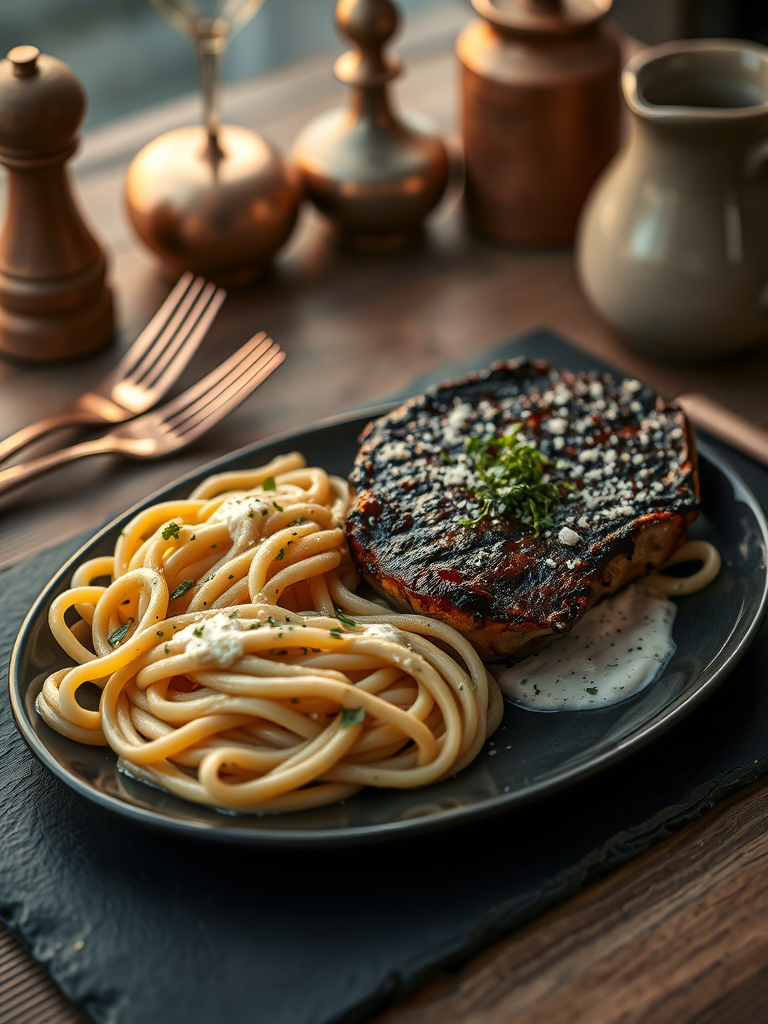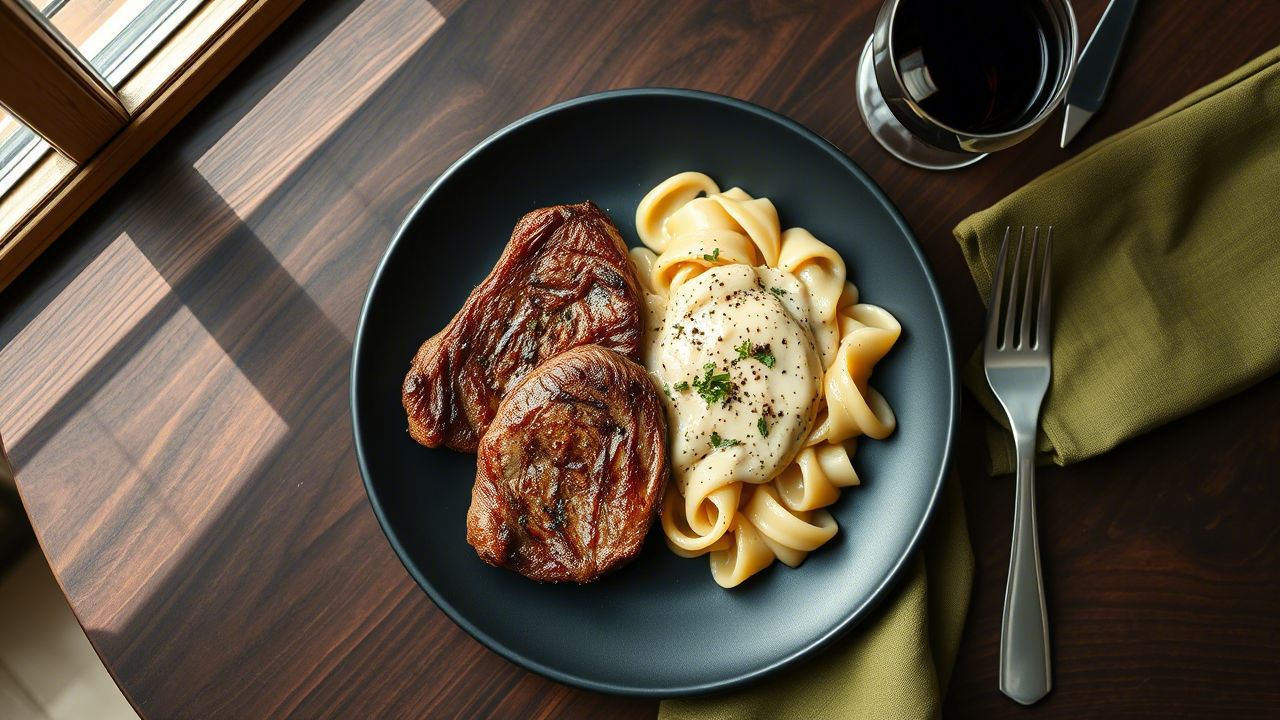There are dinners that whisper. Then there are those that walk in, slam the door, and demand your attention. Garlic Butter Steak with Creamy Parmesan Rigatoni does the latter. It’s bold, buttery, rich, and surprisingly balanced. Not the sort of dish you toss together in a hurry, but the one that earns you hushed respect from anyone who knows their way around a knife and flame.
This isn’t just about searing a steak or boiling pasta. This is about control, finesse, and understanding the behavior of fat, heat, and timing. About combining muscle with softness — charred meat and silky rigatoni — in a way that somehow just makes sense.
Let’s get into it.
Why This Dish Works: Meat Meets Cream, and It’s Not a Fight
Let’s be real for a second. Steak and pasta? Sounds like overkill at first glance. But it ain’t.
When done wrong, it’s greasy, heavy, and muddled. But when you build contrast into the structure — say, a hard-seared ribeye with a garlic-forward butter sauce, paired with rigatoni that’s clinging onto a silky, salty Parmesan cream — that’s when the magic shows up.
This dish isn’t just indulgent. It’s intentional. Each component plays a role, and the technical backbone is sound.
The Steak: Controlled Chaos on a Hot Pan
You’re not cooking the steak. You’re managing it. Babysitting it like it might try to fight you.
Use ribeye. Bone-in, if you can get it. The fat cap and marbling are essential — not optional. And you want something at least 1.5 inches thick. Anything thinner, and you’re just… steaming meat.
Bring it to room temp, always. Cold steak on a hot pan is just cruel. It’ll seize up, cook uneven, and refuse to develop a crust.
Now, heat a cast iron skillet until it feels like regret. That’s right. You want it screaming hot. No oil just yet — get it dry first.
Pat your steak dry. Season aggressively. Salt and cracked black pepper. That’s it. If you season like you’re afraid of hypertension, you might as well be boiling chicken breast.
Drop the steak. Listen for that slap and immediate sizzle. Don’t touch it. Seriously, don’t. Let the crust build. Flip only once. Maybe twice if you’re feeling cheeky.
Now comes the butter — but not at the start. That’s for later. Lower the heat just a tick, toss in 2–3 tablespoons of unsalted butter, crushed garlic cloves (skin on), and a few woody herbs like thyme or rosemary.
Tilt the pan, baste like you mean it. Spoon that sizzling butter over the top. Keep going until the steak hits your target temp — 125°F for rare, 130–135°F for medium rare. Use a thermometer. You are not Gordon Ramsay. Yet.
Let it rest. Minimum five minutes. Don’t even look at it while it rests.
Garlic Butter: It’s Not a Sauce, It’s a Mood
Butter, garlic, and herbs. That’s it, right?
Well, yes. But also, no.
You’re not just melting butter. You’re infusing it. Think of it like making a butter-based stock. When the garlic hits that hot fat, it opens up. Turns mellow. Nutty, even.
Use unsalted butter — European if you can swing it. Higher fat content, creamier melt. Don’t skimp on the garlic. Four cloves minimum, smashed with the flat of your knife. Add herbs — thyme works, but sage has this haunting earthiness that’s criminally underrated.
Optional: a splash of lemon juice at the end. It cuts through the fat and makes everything pop. But that’s your call.

Rigatoni: Creamy, Salty, Decadent — Not Dull
Now for the part that surprises people. The rigatoni.
Most folks hear “creamy pasta” and imagine a cloying, goopy mess. You’re not making Alfredo here. You’re emulsifying cheese and cream with starchy pasta water to get something that’s glossy, smooth, and coats the pasta just right.
Cook the pasta in heavily salted water — like, salty enough to raise eyebrows. Undercook it slightly. About a minute shy of the box directions. We’re finishing it in the sauce anyway.
In a separate pan (don’t reuse your steak pan unless you want muddled flavors), melt butter. Add minced shallots or garlic if you’re feeling fancy. Pour in heavy cream, bring it to a bare simmer. Not a boil — you’re not making chowder.
Toss in freshly grated Parmigiano Reggiano — and please grate it yourself. Pre-shredded cheese has anti-caking agents that’ll make your sauce grainy. No shortcuts here.
Whisk it into the cream. Add a ladle of pasta water. Stir. Taste. Adjust with salt, black pepper, maybe a dash of nutmeg if you’re bold. Add the pasta. Toss until the rigatoni drinks up the sauce.
It should look like satin. If it clumps, you messed up the ratio. Add more water, not cream. Cream alone doesn’t fix bad emulsification.
Bringing It Together: It’s Not Just Plating, It’s Architecture
This ain’t fine dining, but you still gotta care about how it lands on the plate.
Slice your rested steak against the grain. Thick or thin — personal call — but always at an angle.
Spoon the creamy rigatoni down first, make a little bed. Lay the steak slices on top or fan them around, however your heart tells you.
Drizzle reserved garlic butter over the top — don’t forget those crispy garlic bits and herbs. Add a crack of fresh pepper. Maybe a flurry of extra Parmesan. Chopped chives if you’re showing off.
That’s it. No microgreens. No balsamic drizzle. Don’t ruin it.
Variations That Don’t Suck
Not a fan of ribeye? Fine. Use New York strip or hanger steak. Just keep that fat content in mind — lean cuts dry out quick.
For the pasta, rigatoni’s ideal. Holds sauce like a champ. But penne rigate, casarecce, or even cavatappi can work. Just not spaghetti. That’s a crime in this context.
Want more depth in the sauce? Add pancetta or guanciale. Cook it first, render the fat, and build your cream base from there.
Feeling extra? Finish the steak in the oven with blue cheese crumbles. Or torch the top before slicing.
Nutrition Breakdown: It’s Rich, But Here’s the Math
This is not diet food. But let’s talk ballpark numbers, per serving (serves 2 generously):
- Calories: ~950–1100
- Protein: 50–60g
- Fat: 60–70g
- Carbs: 60–70g
It’s energy-dense, yes. But it’s balanced if you know your macros. Add a green — sautéed spinach or a sharp arugula salad with lemon vinaigrette — to cut the heaviness.
Common Mistakes Pros Still Make
1. Overcooking the steak. Even chefs mess this up when they get distracted. Don’t rely on “feel” unless you’ve cooked 10,000 steaks.
2. Breaking the cream sauce. High heat + cheese = disaster. Keep it low, stir constantly, and don’t be afraid to use pasta water.
3. Undersalting. This dish needs salt. It’s the backbone. Underseasoned steak + bland sauce = disappointment.
4. Rushing the butter. You want that garlic to caramelize gently. Brown butter notes take this to a whole different level.

Trends in Steak-Pasta Pairings
We’re seeing more upscale bistros lean into steak-pasta duos. It’s comfort food meets fine dining — and diners love that middle ground.
Some kitchens are using aged beef fat in their cream sauces. Others are torching parmesan crusts over the top like crème brûlée. That blend of rustic and refined? It’s in.
Expect more dry-aged sirloin paired with house-made garganelli. Or duck-fat ribeye with ricotta gnocchi. It’s not going away.
Final Thoughts: Don’t Just Cook It, Understand It
Garlic Butter Steak with Creamy Parmesan Rigatoni isn’t just indulgent. It’s a lesson in contrast, in control, in restraint. You’re balancing muscle and richness, char and cream, salt and fat.
You could teach a class on this dish. Or just make it for someone you want to impress. Either way, cook it like you mean it. That’s what separates a plate of food from a plate of feelings.
So next time someone says steak and pasta don’t belong on the same plate?
Make this. And don’t say a word. Just let ‘em eat.
FAQs
What cut of steak is best for garlic butter steak?
Ribeye is ideal due to its marbling and flavor, but New York strip or hanger steak also work well.
Can I use pre-shredded Parmesan for the rigatoni?
No — it can make the sauce grainy; always use freshly grated Parmigiano Reggiano.
What type of pasta works best with the creamy Parmesan sauce?
Rigatoni is perfect, but penne, casarecce, or cavatappi are decent alternatives.
How do I stop the cream sauce from curdling?
Keep the heat low and add cheese gradually with pasta water to emulsify properly.
Do I need to rest the steak after cooking?
Yes — at least five minutes to retain juices and avoid dryness.
Should garlic butter be added during or after cooking the steak?
Add it toward the end of cooking to avoid burning and infuse flavor.
Can I make this dish ahead of time?
Not recommended — both the steak and sauce are best served fresh.
How salty should the pasta water be?
Salty like the sea — it’s the only chance to season the pasta itself.
Is it okay to skip the herbs in the butter?
You can, but thyme, rosemary, or sage add deep aromatic layers that elevate the dish.
What side dishes pair well with this meal?
Sharp arugula salad or sautéed greens help balance the richness beautifully.

Mariana is a passionate home cook who creates delicious, easy-to-follow recipes for busy people. From energizing breakfasts to satisfying dinners and indulgent desserts, her dishes are designed to fuel both your body and hustle.
When she’s not in the kitchen, she’s exploring new flavors and dreaming up her next recipe to share with the Foodie Hustle community.

